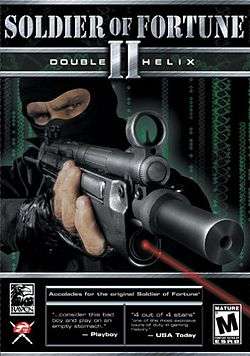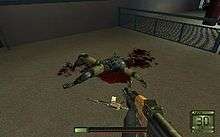Soldier of Fortune II: Double Helix
| Soldier of Fortune II: Double Helix | |
|---|---|
 | |
| Developer(s) |
Raven Software Gratuitous Games (Xbox port) |
| Publisher(s) | Activision |
| Director(s) | Jon Zuk |
| Designer(s) | Matt Pinkston |
| Series | Soldier of Fortune |
| Engine | Quake III: Team Arena (with Raven's custom SDK) |
| Platform(s) |
Windows Mac OS X Xbox |
| Release date(s) | May 20, 2002 |
| Genre(s) | First-person shooter |
| Mode(s) | Single-player, multiplayer |
Soldier of Fortune II: Double Helix is a video game created by Raven Software, a sequel to Soldier of Fortune. It was developed using the Quake III: Team Arena engine. Once again, Raven hired John Mullins to act as a consultant on the game. Based on comments and criticisms of the original game, Raven Software developed Soldier of Fortune II to be a more "realistic" game, with tactical shooters like Operation Flashpoint: Cold War Crisis and Tom Clancy's Rainbow Six as inspirations rather than Quake. A sequel titled Soldier of Fortune: Payback, made by Cauldron HQ was released for Microsoft Windows, PlayStation 3 and Xbox 360 in 2007.
Story
The theme of the sequel is germ warfare, as the mercenary Mullins and his new partner Madeline Taylor travel to Colombia to investigate a viral outbreak in a small town, only to link it to a shadowy organization called Prometheus. The virus, called Romulus, is followed by a computer virus called Remus which is programmed to delete files on any computer in the world, in this case, files relating to Prometheus and Romulus, so an anti-virus cannot be formulated. Prometheus then plans to blackmail the G8 countries at a summit in Switzerland for billions of dollars. It is revealed throughout the course of the game that a mole inside The Shop may be feeding information to the terrorists.
Major characters
- John Mullins: Born and raised in Southwest Oklahoma, Mullins served three tours in Vietnam, earning three Purple Hearts. He was also a member of the controversial Phoenix Program group created to assassinate high ranking Vietcong officers. Mullins retired from the military to become a "consultant", or mercenary, 12 years ago. He now takes jobs from the United Nations anti-terrorist group called The Shop. With a medium build, Mullins boasts strength and speed that few men possess. John Mullins is voiced by Todd Susman.
- Madeline Taylor: With the death of John's lifelong friend and partner, Hawk, The Shop looked long and hard for a suitable match to John's can-do attitude. Although a fully trained field agent, Taylor's specialty is human medical research, making her an invaluable ally in the fight against chemical and biological weapons. Madeleine Taylor is voiced by Iris Bahr.
- Sam Gladstone: A 62-year-old bearded book store owner and part-time employee of The Shop. A Captain in Vietnam, Gladstone excelled at recon, later spending several years with the CIA. He owns the small enterprise known as Goldberg's Used Books. Behind the old bookshelves however lies a hidden lab filled with the latest technology and weapons. Sam Gladstone is voiced by Earl Boen.
- Dr. Piotr Ivanovich: One of the Soviet Union's top Biopreparat scientists, Dr. Ivanovich has worked on chemical weapons for a very long time. Unlike his cohorts however, he wants out. Ivanovitch has extensive knowledge in his head which certain terrorist groups would kill for, and he has passed most of this knowledge on to his young protege, Dr. Dmitry Sestrogor. Dr. Piotr Ivanovich is voiced by Alan Oppenheimer.
- Dr. Dmitry Sestrogor: A mysterious figure, Dmitry Sestrogor has been behind the production of many deadly bio-weapons which have been used throughout the world. This man, however, is no criminal mastermind. Held hostage by the ruthless Prometheus group, Dr. Sestrogor has been forced to develop deadly weapons in exchange for his life. Dr. Dmitry Sestrogor is voiced by Michael Bell.
- Anthony Michaels: The Shop's director, Michaels operates under the strictest of secrecy. For years he has pushed The Shop forward, hoping to bring terrorism under control. Michaels is an extremely powerful figure in his own right, being the head of an organization that owes no allegiance to any government and having a vast network of informants and agents across the world. Anthony Michaels is voiced by Cam Clarke.
Other characters in the game includes Assistant Director Wilson (Mark Hamill), Deviant1 (Rosalind Chao), Manuel Vergara (Gustavo Vargas) and Alex 'Skip' Larson (Dee Bradley Baker).
Gameplay

The series' focal point, graphic depiction of human bodily dismemberment, makes another appearance in Soldier of Fortune II. GHOUL 2.0, as the new engine was called, features 36 gore zones, allowing for increasingly detailed depictions of gore and carnage.
In contrast with the first game, Soldier of Fortune II has a more diverse number of real-life weapons. Several of the weapons can have special attachments such as a laser sight. In the single player campaign, it is also possible to have mixed akimbo weapons.
Unlike the original game, there are no futuristic weapons or sci-fi elements. The most advanced weapon encountered is the OICW, which is based on a former weapon prototype of the United States military.
Multiplayer
In multiplayer mode, there are five gametypes: Capture the Flag, Infiltration, Team Deathmatch, Deathmatch and Elimination. The Gold Edition of the game adds an extra gametype: Demolition, bringing the number of gametypes in the game to six.
- In Capture the Flag, all players are divided into two teams: a red team and a blue team. The objective is for one team to get the flag of the other team, located in the enemies base, and bring it back to their own base. Once a team hits the number of flags captured the team win the game or once the time limit has been reached, the team with the biggest number of flags captured wins the game. Killed players will respawn after a few seconds.
- In Infiltration, all players are divided into two teams: a red team and a blue team. A suitcase is placed in a neutral location on the map. Both teams have different objectives: the blue team has to carry the suitcase to a rendezvous point, while the red team is to protect the suitcase at all costs, and to prevent the blue team from taking the suitcase to the rendezvous point. The round ends when either the blue team successfully brings the suitcase to the rendezvous point, the blue team eliminates every member of the red team, or if the red teams eliminates every member of the blue team. Unlike Team Deathmatch and Deathmatch, killed players do not respawn, staying dead until the end of the round.
- In Team Deathmatch, all players are divided into two teams: a red team and a blue team. The objective of Team Deathmatch is to be the first team to hit the frag limit, which can be achieved by killing opposing players, and by avoiding death from opposing players. Once a team hits the frag limit, they win the game and the round finishes. Depending on the admin/creator's choice, friendly fire may or may not be allowed. Killed players will respawn after a few seconds.
- In Deathmatch, players play with the same rules as Team Deathmatch, except that the players will now be playing by themselves. The objective of Deathmatch is to be the first player to hit the frag limit, or to have the highest amount of kills once gametime expires. This can be achieved by killing other players while avoiding death from other players. Once a player hits the frag limit, the player wins the game and the round finishes. Killed players will respawn after a few seconds.
- In Elimination, players play with the same rules as Team Deathmatch, except with one major difference - killed players do not respawn. To objective of the game is to hunt down and kill members of the opposing team players whilst avoiding death. The team that manages to successfully eliminate the other team wins the game. Unlike Team Deathmatch and Deathmatch, killed players do not respawn, staying dead until the end of the round.
- In Demolition, all players are divided into two teams: a red team and a blue team. The blue team's objective is to plant a bomb, which is given to a player at random at the beginning of the round, at one of two bombsites and to ensure its detonation. The red team's objective on the other hand, is to prevent the bomb from being planted by the blue team, and to defuse the bomb before it explodes if the blue team manages to successfully plant it. The round ends when either the blue team successfully ensures the detonation of the bomb, the blue team eliminates every member of the red team, the red team defuses the bomb or the red team successfully eliminates every member of the blue team. Unlike Capture the Flag, Team Deathmatch and Deathmatch, killed players do not respawn, staying dead until the end of the round. This gametype is very similar to the Bomb Defusal gametype of Valve's Counter-Strike series.
Reception
Soldier of Fortune was praised as being a solid and entertaining shooter, with one of the game's greatest praises being its graphic depiction of gore and violence, which both proponents and detractors consider to be more realistic than most first-person shooter games.
The PC version of Soldier of Fortune II: Double Helix received mostly positive reviews, however, there was some speculation that it had been rushed in order to avoid cannibalizing sales of Star Wars Jedi Knight II: Jedi Outcast (also produced by Raven Software), another title released within weeks that was also based on the Quake III: Team Arena engine. As a result of its apparent premature release, parts of the game seem unbalanced or unpolished, presumably due to a lack of extensive playtesting.[1]
The stealth mode was criticized as overly simplistic since alerting sentries triggers alarms which can not be turned off for the duration of the mission. This nullified further attempts at proceeding through clandestine means, making sneaking and suppressed weapons useless, and forcing the player to resort to a straightforward attack in order to complete the level. However, assaulting was very difficult in certain situations as engaging in firefights could be deadly. The only practical way to overcome this was to reload the level or start from scratch.
Upon release the game was filled with many crippling bugs such as problems with performance and a tendency to lock up easily, which was fixed in the Gold edition. The Gold edition also boasted new content such as more maps and new weapons to use. This additional content was also included in the Xbox port.
The Xbox version was heavily criticized since it did not improve on any of the PC version's flaws despite an additional year of development time, so it did not keep pace with the advancements in competing first person shooter games. It also had graphics far below what was expected for the Xbox, with bland textures and a low polygon count that led some reviewers to describe it as a "PC to Dreamcast to Xbox port".
Sequels
Based on its success, initially released for Windows, Soldier of Fortune II: Double Helix was later ported to the Xbox.
A third game in the series, Soldier of Fortune: Payback was made by Cauldron HQ and released on November 14, 2007.
A MMOFPS based on the series, Soldier of Fortune Online was published in Korea by Dragonfly and went in Closed Beta on August 12, 2010 and ended on August 16, 2010.
References
- ↑ Sulic, Ivan (20 May 2002). "Soldier of Fortune II: Double Helix". IGN Entertainment. p. 1. Retrieved 2 August 2011.
…this sequel comes plagued with a lot of annoying, but minor bugs and questionable design decisions that could have benefited greatly from further balance, testing, and development.